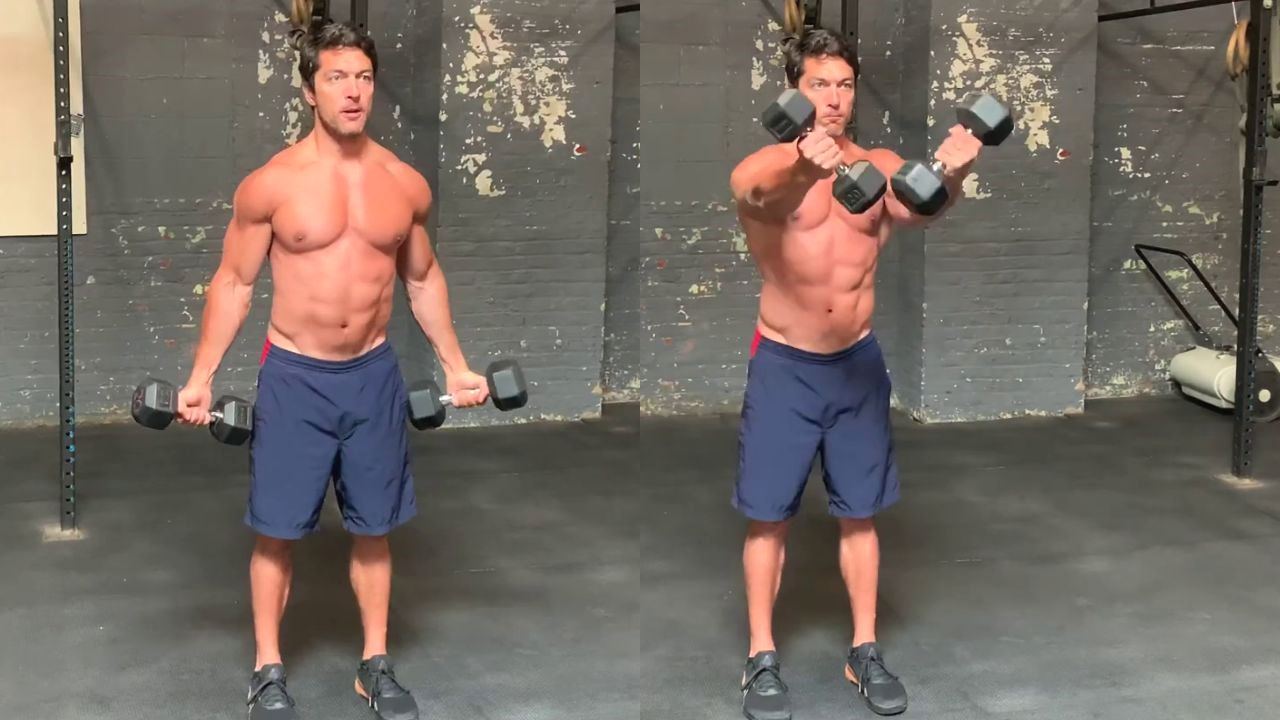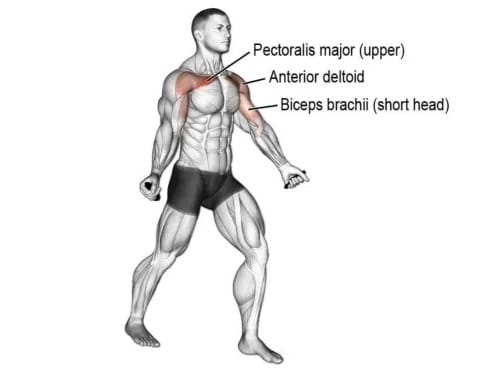Are you looking to add a challenging and effective exercise to your chest workout routine? Look no further than standing dumbbell fly.
The standing dumbbell fly is a variation of the traditional dumbbell chest fly exercise that targets the chest and shoulder muscles.
This exercise challenges your upper chest muscles in a way that the bench fly cannot.
In this blog, we’ll break down everything you need to know about the standing dumbbell fly:
- What it is
- Muscles Worked
- Its unique benefits
- How to do
- Its variations

- What is Standing Dumbbell Flys
- Muscle Worked During Standing Dumbbell Fly
- How To Do Standing Low To High Dumbbell Chest Fly
- Tips and Forms For During Standing DB Fly
- Standing Single Arm Dumbbell Chest Fly
- How To Do Standing Single-Arm Dumbbell Flys
- Benefits of Standing Chest Fly
- What Are The Best Alternate Of Standing Chest Fly
- 1. Incline Dumbbell Squeeze Press
- 2. Incline Dumbbell Fly
- Standing dumbbell fly vs lateral raise
- Frequently asked questions
- Is standing dumbbell fly good?
- Does standing dumbbell chest fly work?
- What is a good standing dumbbell fly weight?
- Can standing flies be done without dumbbells?
- Can standing flies be done with one arm at a time?
- Takeaway
What is Standing Dumbbell Flys
Standing flys, also known as standing upward fly, is an isolation exercise primarily targeting the chest and shoulder muscles.
It is a bodybuilding favorite exercise that is usually performed after big compound lifts, like the bench and incline dumbbell press.
During the standing dumbbell fly, your hands and arms move in a smooth arc, kind of like you’re giving yourself a big hug. This flying motion from a low to high position really targets those upper chest muscles.
It is considered to be the perfect finishing move and a great way to focus on your chest after many pressing exercises.

Muscle Worked During Standing Dumbbell Fly
The standing low to high dumbbell chest fly primarily works the inner and upper pectoralis muscles.
The standing upward chest fly has the involvement of several synergist muscles, these muscles include,
- Rhomboids,
- Levator scapulae,
- Anterior deltoids, and
- Latissimus dorsi.
A handful of other muscles worked or play the role of stabilizer muscles during standing chest fly, including your
- Biceps brachii,
- Brachialis,
- Triceps brachii,
- Wrist flexors,
- Obliques, and
- Rectus abdominis.

How To Do Standing Low To High Dumbbell Chest Fly
- Stand with feet shoulder-width apart and knees slightly bent for stability.
- Choose a pair of light to moderate dumbbells and hold one in each hand.
- Hold a dumbbell in each hand with your palms facing upward.
- Keep a slight bend in your elbows.
- Raise the dumbbells up and together so that they come together at shoulder level or slightly higher.
- Slowly lower back to the starting position
- Do 8-12 and 3-4 sets.

Tips and Forms For During Standing DB Fly
- Perform this exercise slow and controlled, really focusing on the eccentric contraction.
- Exhale during the concentric (muscle-shortening) part of the motion.
- Start with a light set of weights if you’re a beginner, and slowly increase the amount of weight each week as you build strength.
- Maintain the slight elbow bend throughout the downward movement.
- Don’t let the dumbbells touch as they meet at the top, holding for a second in the contracted position.
- Internally rotate your wrists towards the top of the movement to allow for maximum contraction of the chest.
- Pick a weight that you can control, that’s not too light or too heavy — find what’s right for you.
- If you are new to performing standing dumbbell flies OR you may want to apply a few modifications to make the exercise easier. One way to counter this problem is to use a lighter weight.
- If you are looking for a more advanced variation to stimulate different muscle fibers in the chest, then try the one-arm standing dumbbell fly.
Read More To Know More: Chest Dumbbell Fly: Muscle Worked, Foam, Alternative
Standing Single Arm Dumbbell Chest Fly
A one-arm standing dumbbell fly is a unilateral variation of the traditional standing fly exercise that involves performing the movement with one arm at a time.
It helps to improve muscle imbalances between the left and right sides of the body.
It also improves range of motion and flexibility, providing a more isolated workout for the chest and shoulder muscles.

How To Do Standing Single-Arm Dumbbell Flys
- Stand with your feet shoulder-width apart and hold a dumbbell in one hand.
- Keep your back straight and your core engaged.
- Raise the dumbbell so that it is at shoulder level or a little higher than shoulder level.
- Slowly lower back to the starting position
- Repeat for the desired number of reps before switching to the other arm.
Benefits of Standing Chest Fly
Standing Dumbbell chest fly exercises provide some benefits.
Let’s take a look at the benefits of doing a Standing dumbbell fly.
- Standing dumbbell Chest flies are a great alternative for people who experience discomfort in their joints during the bench press.
- The Standing upward chest fly can help open up your chest muscles. Chest openers may help reduce upper back pain, increase range of motion, and reduce tightness in the upper body.
- This is perfect for people working out at home without a bench.
- Doing chest exercises with dumbbells makes your muscles work harder because they have to constantly keep the weight under control.
- Dumbbells allow you to move them through a greater range of motion.
- Dumbbells will immediately let you know if one side of your body is stronger or weaker than the other side.
What Are The Best Alternate Of Standing Chest Fly
Before diving deep into the best standing upward chest alternatives, We must remember that a good-standing dumbbell chest fly alternative will satisfy the following criteria.
- Activate the chest muscle groups, which are trained in the low to high dumbbell chest fly.
- Isolate the muscle groups during execution.
- Train the chest muscle through a longer range of motion.
1. Incline Dumbbell Squeeze Press
The incline dumbbell squeeze press is one of the most effective chest pressing exercises that target the inner chest and upper chest.
During the squeeze press, the dumbbells are always in contact with each other, and you’re actively squeezing them inward (against each other) as hard as possible.
2. Incline Dumbbell Fly
The incline dumbbell fly is a great alternative to the standing dumbbell fly. This is one of the best upper chest exercises that you can do during your upper pecs workout.
Do not only perform a basic flat bench fly, but also add incline variation because the incline bench position allows for isolating the harder-to-develop upper pectorals.
Standing dumbbell fly vs lateral raise
- The standing dumbbell chest fly primarily targets the chest and shoulder muscles, while the lateral raise primarily targets the shoulder muscles.
- The standing dumbbell chest fly involves bringing the arms across the body while holding weights, while the lateral raise involves raising the arms out to the sides.
- Standing dumbbell chest fly is a more compound exercise that involves multiple muscle groups, while lateral raise is more isolated to the lateral deltoid.
Frequently asked questions
Is standing dumbbell fly good?
Yes, the standing dumbbell chest fly is a good exercise to target your mid and upper chest. With just a pair of dumbbells, you can strengthen your chest and make it broader and more developed.
This is ideal for people working out at home without a bench.
Does standing dumbbell chest fly work?
Yes, A dumbbell fly works and helps to train the middle and upper parts of your chest muscles, this exercise also helps to strengthen the front, middle and posterior deltoids of your shoulders.
A handful of other muscles, worked or played the role of stabilizer muscles, during Standing chest fly.
What is a good standing dumbbell fly weight?
When doing dumbbell flies, it’s best to choose a weight that’s appropriate for your fitness level. If you are new to weight lifting, starting with a light weight of 3 to 5 pounds is recommended.
If you are experienced, you may want to use 8 to 10 pound weights.
Can standing flies be done without dumbbells?
Yes, standing flies can be performed without a dumbbell by using resistance bands or water bottles instead.
Can standing flies be done with one arm at a time?
Yes, it is possible to do standing flies with one arm at a time to help improve muscle imbalances and increase the range of motion in the chest and shoulder muscles. This variation is called the standing single-arm dumbbell fly.
Takeaway
The Standing dumbbell chest fly may be a good exercise if you’re looking to build strength in your chest, shoulder, and arm muscles. Dumbbell flyes are, for the most part, underrated and often overlooked.
References
- Solstad TE, Andersen V, Shaw M, Hoel EM, Vonheim A, Saeterbakken AH. A Comparison of Muscle Activation between Barbell Bench Press and Dumbbell Flyes in Resistance-Trained Males. J Sports Sci Med. 2020 Nov 19;19(4):645-651. PMID: 33239937; PMCID: PMC7675616.
- Reiser, Fernando & Lira, Jumes & Bonfim, Beatriz & Filho, Solival & Durante, Bruno & Cardoso, João & Miotto, Hamilton & Soares, Marcos & Bonuzzi, Giordano & Tavares, Lucas. (2017). Electromyography of Dumbbell Fly Exercise Using Different Planes and Labile Surfaces. Journal of Exercise Physiology Online. 20. 31.

Manish brings over 10 years of hands-on experience in weight lifting and fat loss to fitness coaching. He specializes in gym-based training and has a lot of knowledge about exercise, lifting technique, biomechanics, and more.
Through “Fit Life Regime,” he generously shares the insights he’s gained over a decade in the field. His goal is to equip others with the knowledge to start their own fitness journey.
